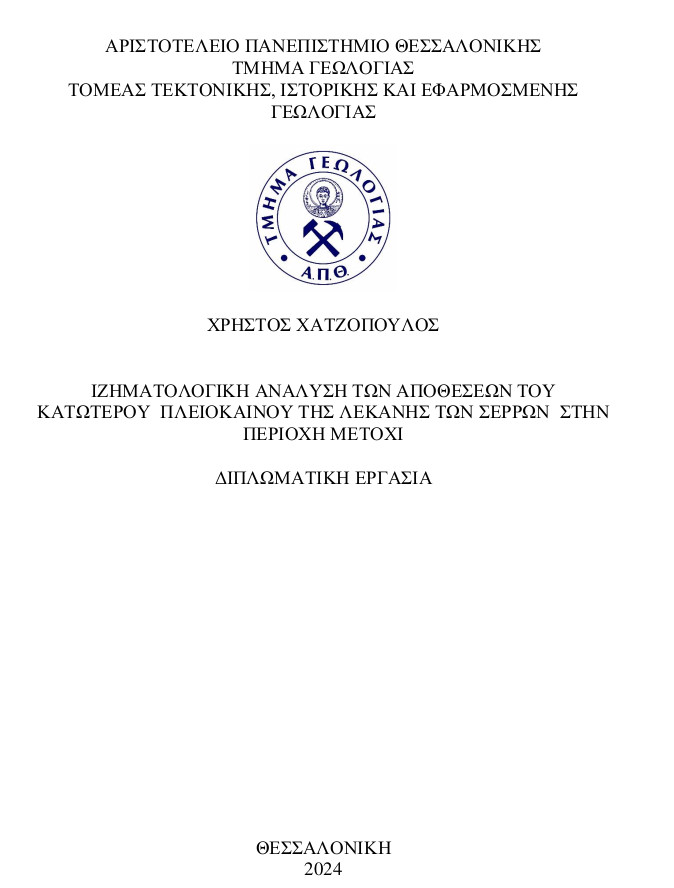
Ιζηματολογική ανάλυση των αποθέσεων του κατώτερου Πλειόκαινου της λεκάνης των Σερρών (περιοχή Μετόχι) = Sedimentological analysis of the lower pleiocene deposits in Serres basin (Metochi region).
Περίληψη
Εκτεταμένη μελέτη πάνω στην ιζηματολογία έλαβε χώρα στον σχηματισμό των ψαμμιτών του Γεωργίου, στην περιοχή του Μετοχίου της λεκάνης Σερρών. Συγκεκριμένα, με την μέθοδο της φασικής ανάλυσης αποδείχθηκε ότι πρόκειται για ένα μεταβατικό περιβάλλον ιζηματογένεσης ,πιθανότερα μιας δελταϊκής πλατφόρμας. Η έρευνα έδειξε ότι κυριαρχούν επτά είδη ιζηματογενών φάσεων, οι οποίες συγκροτούν έναν συσχετισμό φάσεων, δηλαδή το μεταβατικό περιβάλλον ιζηματογένεσης. Πρόκειται για ένα αρκετά ενεργό και δυναμικό σύστημα, καθώς φαίνεται ότι επηρεάζεται από την παλιρροϊκή δράση μέσα από συγκεκριμένες δομές που παρατηρούνται στο ύπαιθρο. Η απόδειξη ότι επηρεάζεται το σύστημα από παλίρροιες φαίνεται μέσα στους ψαμμίτες που είναι πλούσιοι σε άμμο, περιέχουν αργιλικές δομές που ανάλογα το σχήμα και την κλίση τους δείχνουν την διεύθυνση της μετατόπιση των θινών. Η λεκάνη των Σερρών ηλικιακά θεωρείται ως νέα καθώς αποτελείται από Νεογενή και Τεταρτογενή ιζήματα, ενώ παλαιότερα δεν υπήρξε ιζηματογένεση.
A detailed study took place upon the sedimentology of the Georgios sandstone formation, in the region Metochi of the Serres basin. Specifically, using the method of facies analysis it was proved that the formation used to be marginal marine deposit environment, probably a delta plain. The study showed that there are seven facies combined into one facies association, which is the marginal marine deposit environment. It has to do with an active and dynamic flow system, based on the tidal influence that is indicated through observation of specific structures in the field. The proof that the system is tidally influenced comes up from the sandstones, rich in sand, that contain mud structures with specific architecture and dip that interpret the migration of the sand dunes. The Serres basin is recently created because the sediments it contains were created and deposited in the Neogene and Quaternary, therefore sedimentation never existed before.
Πλήρες Κείμενο:
PDFΑναφορές
Alexander J & Fielding C (1997) Gravel antidunes in the tropical Burdekin River, Queensland, Australia. Sedimentology 44, 327–37.
Armour-Brown, A., De Bruijn, H., Maniati, C., Siatos, G., Niesen, P.(1979). The geology of the Neogene sediments north of Serrai & the use of rodent faunas for biostratigraphic control. Proceedings, Vol. I, p.p. 615-622.
Collinson, J.D, Mountney, N.P, & Thompson DB. (2006). Sedimentary Structures, 3rd edn. Harpenden: Terra Publishing.
Di Celma, C., Cantalamessa, G., Landini, W., & Ragaini, L. (2010). Stratigraphicevolution from shoreface to shelf-indenting channel depositional systemsduring transgression: insights from the lower Pliocene Súa Member of the basal Upper Onzole Formation, Borb´on Basin, northwest Ecuador.Sedimentary Geology 223, 162–79.
Dinter, D. & Royden, L. (1993). Late Cenozoic extension in northeastern Greec e: Strymon Valley detachment system and Rhodope metamorphic core complex. Geology 21:45-48.
Karistinaios, N.K. (1984). Paleogeographic evolution of the Serres basin: Lithostratigraphy, Biostratigraphy and Tectonics. Aristotle University Of Thessaloniki, Department of Geology, 17-19, 92-109, 187-189.
Kilias, A. & Mountrakis D. (1990). Kinematics of the crystalline sequences in the western Rhodope Massif. Geologica Rhodopica 2:100-116.
Magalhães, A. J. C., Scherer, C. M. S., Raja Gabaglia, G. P., & Catuneanu, O.(2015). Mesoproterozoic delta systems of the Açuruá Formation, Chapada Diamantina, Brazil. Precambrian Research, 257, 1–21.
Maravelis AG, Boutelier D, Catuneanu O, Seymour KS and Zelilidis A. (2016).A review of tectonics and sedimentation in a forearc setting: Hellenic Thrace Basin, north Aegean Sea and northern Greece. Tectonophysics 674, 1–19.
Maravelis, A., Catuneanu, O., Nordsvan, A., Landenberger, B., Zelilidis, A.(2018).Interplay of tectonism and eustasy during the Early Permian icehouse: Southern Sydney Basin, southeast Australia. Geological Journal. 2017;1–32.
Miall, A.D.(1988). Architectural elements and bounding surfaces in fluvial deposits: anatomy of the Kayenta Formation (Lower Jurassic), Southwest Colorado. Sedimentary Geology 55, 233–62.
Nemec, W., & Postma, G. (1993). Quaternary alluvial fans in southwestern Crete: Sedimentation processes and geomorphic evolution. In M. Marzo, & C. Puigdefabregas (Eds.), Alluvial sedimentation. Oxford, UK: Blackwell Publishing Ltd.
Nemec, W., & Steel, R. (1984). Alluvial and coastal conglomerates: Their significant features and some comments on gravelly mass-flow deposits. Sedimentology of gravels and conglomerates. Canadian Society of Petroleum Geologists Memoir, 10, 1-31.
Nichols, G., & Fisher, J. A. (2007). Processes, facies and architecture of fluvial distributary system deposits. Sedimentary Geology, 195, 75–90.
Nichols, G. (2009). Sedimentology and stratigraphy. Wiley‐Blackwell. 432.
Osswald, K.(1938). Geologische geschichte von Griechisch-Nordamakedonien. Υπόμνημα Γεωλ.Υπηρεσίας Ελλάδος,3.
Psilovikos, A., & Psilovikos, A.(2010). Sedimentology, 2nd edition. Tziola Publications. 246-249.
Reineck, H.E, & Wunderlich, F.(1968). Classification and origin of flaser and lenticular bedding. Sedimentology 11, 99–104.
Εισερχόμενη Αναφορά
- Δεν υπάρχουν προς το παρόν εισερχόμενες αναφορές.
